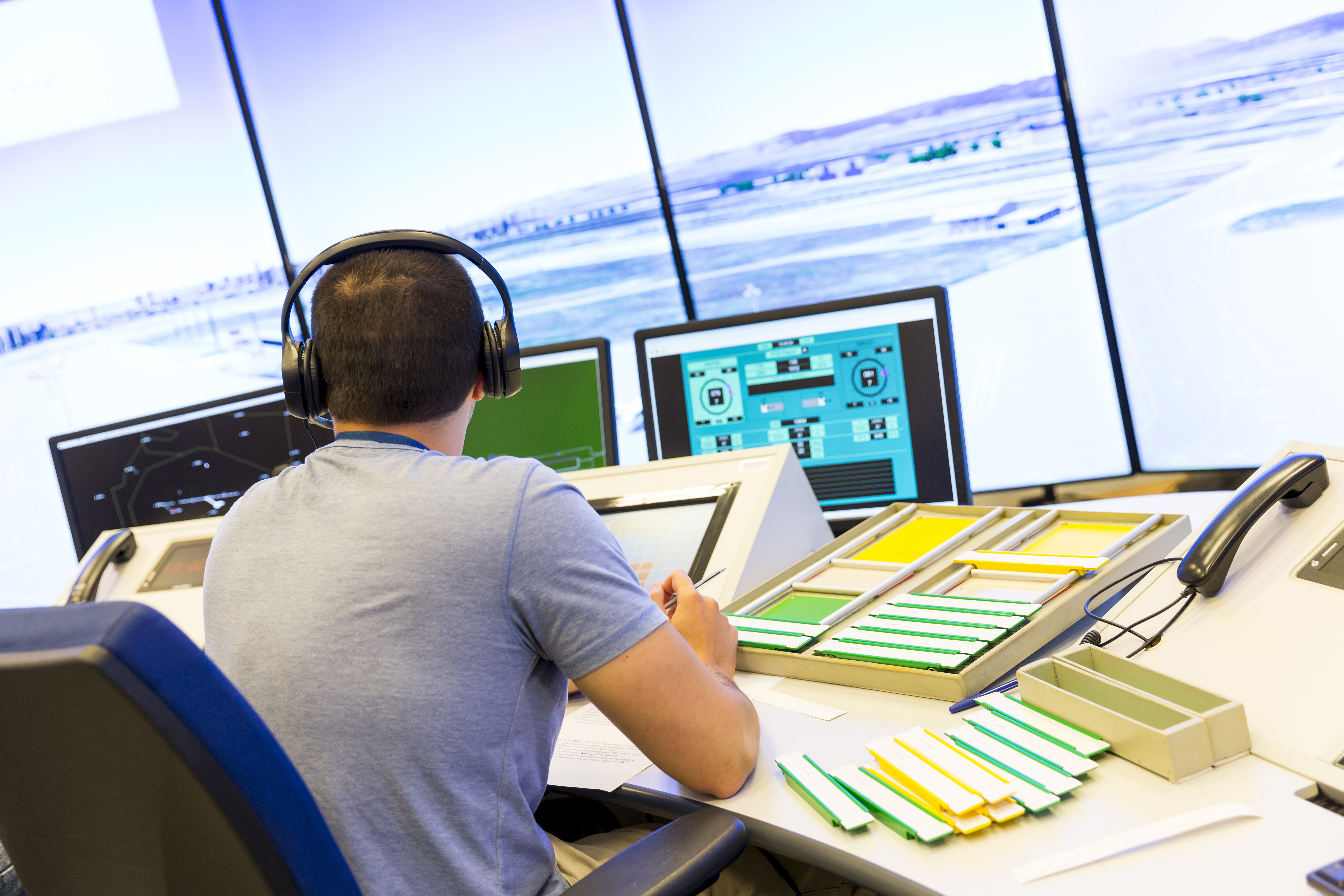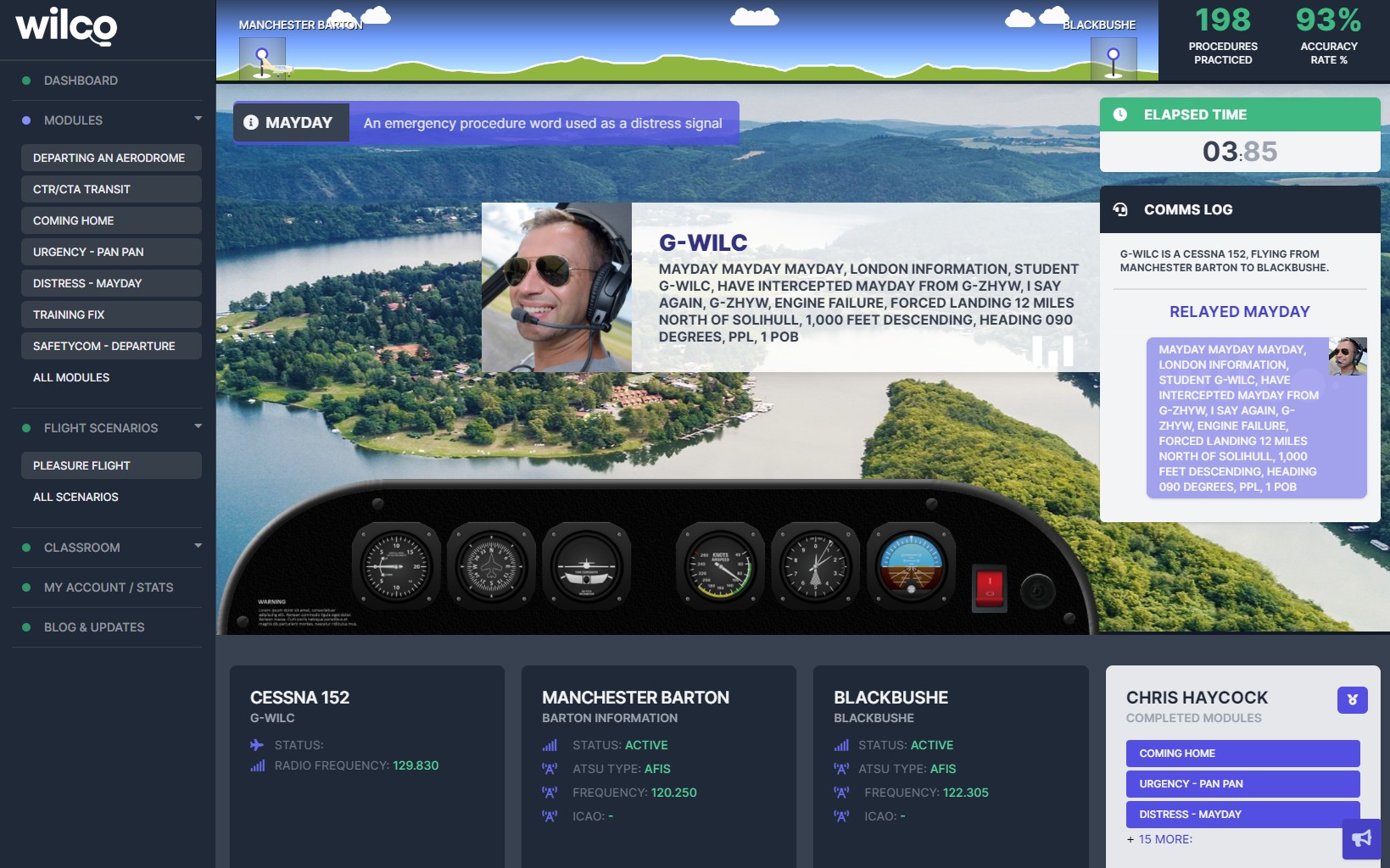WILCO RADIO FEATURES
Beginner's guide to learning aviation radiotelephony (RT)
Are you an aspiring pilot looking to take your skills to the next level? Aviation radiotelephony is an essential part of flying and understanding how it works is key to becoming a competent - and safer - pilot. This beginner’s guide will provide an overview of aviation radiotelephony, as well as help you understand the basics of radio communication whilst flying your aircraft.
Radiotelephony (we refer to it regularly as RT) can be intimidating at first, but with this short guide, you’ll quickly become well-versed in its regulations and procedures. You’ll learn about the different types of calls you can make in the air, as well as what kind of phrases and jargon are used when communicating with air traffic control or other aircraft. Additionally, we'll go over the protocols for emergency situations, so you’re prepared for any eventuality that might arise during flight.

In this guide to RT, you'll understand:
- What aviation radiotelephony (RT) is
- Why learning radiotelephony is mandatory
- The phonetic alphabet - the core element of RT
- Deciphering the abbreviations and acronyms
- Phraseology basics
- Understanding pilot readbacks and acknowledgements
- Describing to ATC your position and intentions
- METAR and TAF weather codes
- Emergency communication techniques
- Using simulators such as Wilco Radio to learn RT
- Tips for staying current with radio communications
By the end of this guide, you'll have a comprehensive understanding of aviation radiotelephony that will serve you well on your journey towards becoming a certified pilot. So if you're ready to get started learning about radio communication in aviation, read on!
What is Aviation Radiotelephony?
First up, what's Radiotelephony (also known as RT) all about? Aviation radiotelephony is a critical skill to learn when flying. It's a form of communication that allows pilots and air traffic controllers to communicate with each other effectively over long distances. Let's face it, it's not uncommon for pilots to communicate with an air traffic service unit (ATSU) as much as 50 miles away. Radiotelephony uses radio waves, which are transmitted via antennas and receivers, to send messages back and forth between the pilot and the ATSU. This method of communication is especially important in times of emergency, during inclement weather conditions, when visibility can be compromised, and aerodrome operations, where the chance of a collision is high.
It's also a legal requirement to learn the correct phraseology too. By law, any pilot who operates an aircraft radio needs a licence (FRTOL - Flight Radiotelephony Operator's Licence) to be able to use it. And to get a licence, you need to learn CAP413-compliant phraseology.
Radiotelephony has many benefits for pilots, including improved situational awareness and enhanced safety. Communication between the pilot and ATC (Air Traffic Control) becomes far more efficient when both parties understand each other quickly and accurately. But it doesn't stop there. Radiotelephony also helps pilots stay informed about current weather conditions as well as any potential hazards in the area.
Learning the correct radiotelephony procedures not only helps ensure safe flight operations but also makes it easier for pilots to coordinate their actions with ATC. With proper instruction, pilots can master this essential skill in very little time, especially with online services such as Wilco Radio. The next step is to explore the benefits of learning radiotelephony further...
Why do I need to learn Radiotelephony?
Learning radiotelephony is critical for pilots who want to stay safe in the air. Communication is essential between pilots and ATS units for the safe and efficient operation of flights, and it's a language that all pilots should be fluent in. Knowing how to communicate effectively will give you an edge when navigating airspace.
Radiotelephony gives pilots the ability to understand and use aviation code words and phrases. Commonly used terms such as “squawk conspicuity”, “MATZ penetration”, and “zone transits” can be confusing at first, but eventually become second nature with practice. Being able to quickly recognise these RT phrases helps ensure that your flights are safe and efficient. What's more, understanding radiotelephony allows pilots to communicate their intentions clearly during flight operations which can help reduce confusion in the air.
As mentioned earlier, learning RT is mandatory for any pilot who uses an aircraft radio to communicate. Mastering radiotelephony is a key component of becoming a successful - and much safer - pilot. Not only does it give you a better understanding of the language used by aviation communicators, but it also ensures that everyone involved in a flight is on the same page. With this knowledge, pilots can confidently navigate airspace without worrying about miscommunication or safety issues resulting from poor communication.
Ready to take your knowledge of aviation one step further? Sign up for a free trial of Wilco Radio, the revolutionary online training platform for pilots!

Using the International Phonetic Alphabet
When learning aviation radiotelephony, the international phonetic alphabet is essential. Every pilot and air traffic controller uses this alphabet to ensure clear and concise communication. The phonetic alphabet is easy to learn, consisting of 26 words that all start with a different letter of the English language. Understanding these words will make it easier for pilots and controllers to better understand each other during times of radio contact.
Here's an example. Since every aircraft has a unique registration (e.g. G-JBHP), pilots need to be able to distinguish their aircraft from others that may be operating in the same airspace. Rather than communicating your aircraft type, the registration letters are used instead. Let's face it, there may be many Cessna 152s operating in a 50-mile radius. ATS units need to know which 152 you are!
In the case above, the registration G-JBHP is communicated over the radio as "Golf Juliet Bravo Hotel Papa".
Learning the phonetic alphabet is easy, and it soon becomes second nature. Firstly, familiarise yourself with each word and its corresponding letter. As you become more comfortable with the words, try saying them aloud at first to understand how they sound when spoken by someone else. Then try using them in sentences you would use when communicating via radio or other methods of air-to-ground communication. Practicing regularly will help you build your confidence in using the international phonetic alphabet correctly.
The International Radiotelephony Spelling Alphabet, commonly known as the NATO phonetic alphabet, NATO spelling alphabet, ICAO phonetic alphabet or ICAO spelling alphabet, is the most widely used radiotelephone spelling alphabet. The ITU phonetic alphabet and figure code is a rarely used variant that differs in the code words for digits.
Here's the full International Phonetic Alphabet to get you started:
| Letter | Spoken Word | Pronunciation |
|---|---|---|
| A | Alfa | AL FAH |
| B | Bravo | BRAH VOH |
| C | Charlie | CHAR LEE or SHAR LEE |
| D | Delta | DELL TAH |
| E | Echo | ECK OH |
| F | Foxtrot | FOKS TROT |
| G | Golf | GOLF |
| H | Hotel | HO TELL |
| I | India | IN DEE AH |
| J | Juliett | JEW LEE ETT |
| K | Kilo | KEY LOH |
| L | Lima | LEE MAH |
| M | Mike | MIKE |
| N | November | NO VEM BER |
| O | Oscar | OSS CAH |
| P | Papa | PAH PAH |
| Q | Quebec | KEH BECK |
| R | Romeo | ROW ME OH |
| S | Sierra | SEE AIR RAH |
| T | Tango | TANG GO |
| U | Uniform | YOU NEE FORM or OO NEE FORM |
| V | Victor | VIK TAH |
| W | Whiskey | WISS KEY |
| X | X-ray | ECKS RAY |
| Y | Yankee | YANG KEY |
| Z | Zulu | ZOO LOO |
When you feel comfortable enough, start practicing with others who are also studying aviation radiotelephony. Working together with someone else will give you both an opportunity to see how well you both understand the concepts while also providing feedback on what needs improvement. This will help you become even more confident in your understanding and application of the international phonetic alphabet which is vital for successful communication in aviation radiotelephony. With practice, mastering this skill will become second nature, getting you one step closer to becoming an expert radio operator!
Using the international phonetic alphabet lays a solid foundation for deciphering ATC abbreviations which can add an extra layer of complexity when communicating via radio or other air-to-ground methods. When you first start learning RT, there are a lot of words, acronyms and abbreviations that are very unfamiliar... at first!
Deciphering radiotelephony abbreviations
If you're just getting into aviation radiotelephony, one of the most difficult parts can be deciphering ATC abbreviations, acronyms and phrases. We won't lie - they may sound like a foreign language at first - because they pretty much are! However, with a bit of practice and some simple tips, you'll soon understand them as well as any seasoned expert. Here's what you need to know.
First, remember that ATC abbreviations are used to reduce the amount of time it takes to communicate over the radio. This means that almost every phrase has been boiled down to its core components, making it easier for pilots and air traffic controllers alike. And don't worry about memorising them all: after a few flights, you'll start recognizing the most common ones without really having to think twice about what they mean.

Finally, practicing your radio communication is key if you want to become fluent in aviation radiotelephony. Take note of any phrases or abbreviations that are unfamiliar to you so you can look them up later - this will help build your understanding and make further studying easier. With enough practice and dedication, you'll be speaking like an expert in no time - we promise!
Phraseology basics
As with anything in life, learning the basics is important.
Radiotelephony is the language used by pilots and air traffic controllers during communication, and it goes without saying that safety and clarity are paramount. Lives are at stake. The phraseology used in this type of communication is unique and specific (and also mandatory), so it's important to understand it's nuances.
The phraseology that's used in aircraft radio communications has a few key components. Above all, your messages should be clear, concise, and precise. Additionally, pilots must use proper and correct phraseology when requesting information or providing information to air traffic controllers to ensure that the communication is clear and efficient.
To become proficient with aviation radiotelephony phraseology, pilots must become familiar with the standard phrases and terms that are used in this type of communication. This means reading up on the standard terminology used in the CAA's Radiotelephony Manual (CAP 413) as well as getting practice with how to properly communicate via radio. With some practice and dedication, pilots can become confident in their ability to communicate safely and effectively over the radio.
Wilco Radio helps you from beginner to pro communicator, introducing you to the different aspects of radiotelephony communications. Our platform allows you to study RT (with an online classroom/course), as well as practice your new skills, using the latest AI technology and speech synthesis. Sign up for a free trial of Wilco Radio now.
Making readbacks and acknowledgements
When flying, communication is key. As such, pilots must understand the basics of making readbacks and acknowledgements. This involves using standard CAP-413 phraseology in order to ensure safe and efficient air traffic control.
To begin with, a "read-back" means repeating back instructions received from an ATSU. It's important for pilots to repeat back every instruction exactly as it was given, including any numbers, altitudes and runways. This ensures that everyone understands the instructions correctly and reduces the chances of errors or misunderstandings - and of course collisions. Pilots should also make sure to pause between each instruction during their read-back so that they can check everything properly (and understand the context) before they take action.
In addition to this, an "acknowledgement" is simply a confirmation that the pilot has heard and understood the message that's communicated to them. This typically includes phrases like “Roger” or “Wilco” which show that the pilot has received and understood the message. It's also good practice for pilots to always double-check their own read-backs to make sure everything is correct before pressing the transmit button.
With these basic concepts under your belt, you are now ready to move on to describing aircraft position and intentions - a crucial part of aviation radiotelephony communication.
Describing aircraft position and intentions
Describing aircraft position and intentions is an important part of aviation radiotelephony communication. It's not just air traffic services that need to know where you are and what you're doing - it's other pilots, and ground staff too. When communicating with ATC, pilots must accurately describe their aircraft's location, direction, altitude, speed, and intentions in order to ensure your -and their - safety. This helps ATC to better manage air traffic control.

The best way to accurately describe your aircraft's position and intentions is to use the standard phraseology that is used in aviation radio transmissions. This is where standard phraseology is so important. Knowing what to say - and where to say it - is critical. That's why Wilco Radio is such a great tool for learning radiotelephony.
It's essential that pilots be able to effectively communicate their aircraft’s position and intentions with ATC in order to ensure safe operations. Making sure that all information provided is clear, accurate, and concise will help avoid any confusion between the pilot and ATC, especially when conditions are poor and visibility is low. With that in mind, let's move onto understanding METARs and TAFs...
Understanding METAR And TAF codes
Pilots need to be familiar with the language of aviation, and a key component of that is understanding the codes used in weather reporting. METAR and TAF are two acronyms that come up frequently, so it's important to know what they refer to. Let's take a closer look at these two codes.
METAR stands for 'Meteorological Aerodrome Report'. This type of report gives current weather conditions at an airport, including wind speed, visibility, cloud cover, temperature, dew point, and other information. These reports are updated regularly as conditions change.
TAF stands for 'Terminal Aerodrome Forecast'. Unlike METARs which report on current conditions, TAFs provide a forecast of expected weather conditions over the next 24 hours or so. They include similar information to METARs plus additional details such as changes in pressure and wind direction over time. Pilots rely on this information when planning flights and deciding whether or not they can take off safely.

Armed with this knowledge about METAR and TAF codes, pilots can be better prepared when it comes to reading weather reports and making decisions about their flights. Knowing how to interpret these types of reports is essential for any pilot looking to stay safe in the air - and now we're ready to move on to transmitting and receiving in an emergency situation.
Transmitting and receiving in an emergency
The ability to transmit and receive in an emergency is a vital skill for pilots. In such critical circumstances, it's important for pilots to be able to communicate clearly and accurately with air traffic control. This means understanding the basic concepts of transmitting and receiving messages, as well as knowing the specific phrases used in emergency situations. Luckily, there aren't many to learn, and the essential phrases are really easy to remember.
To begin with, pilots must understand the different types of transmissions available. For example, there are voice transmissions that use verbal language, as well as non-verbal transmissions that rely on light signals (or even morse code). Once these basics are mastered, pilots should also practice recognizing common emergency phrases such as 'Mayday', and 'Pan Pan'.
Wilco Radio covers all emergency situations in full, and even includes them within practice test routes which you conduct with an AI "Bot".
Ultimately, being able to transmit and receive during an emergency is a key step in mastering aviation radiotelephony. No pilot wants to be in a critical situation without knowing how to communicate the nature of their emergency. With the right training and preparation in Wilco Radio, pilots will be ready for any situation they may encounter while flying. The next section of this guide focuses on practicing with simulators in order to perfect these skills.
Practicing with simulators
When it comes to mastering the art of aviation radiotelephony, practice makes perfect. The use of simulators and online training platforms such as Wilco Radio is a fantastic way to build your confidence in transmitting and receiving radio transmissions. Simulators allow you to gain experience in a safe environment, without any risk or fear of making mistakes.

Rather than risking embarrassment and potential safety issues while communicating with ATC in real-time, simulators let you get comfortable with the basics at your own pace. On Wilco Radio, you can practice with lifelike scenarios that would be difficult or impossible to replicate in real life - such as emergencies or weather-related scenarios.
With regular practice - and a little patience - you'll soon find yourself confidently using aviation radiotelephonic language in no time! And the great thing about Wilco Radio is that you can learn RT in the comfort of your own home, in your own time, and at your own pace.
Wilco Radio is an invaluable tool for any student pilot looking to master the art of aviation radiotelephony. Knowing how to effectively communicate over the radio is just as important as being able to fly an aircraft safely.
Tips for staying current with RT
Staying current with your aviation radiotelephony skills is essential for any pilot, whether they've got 50 or 5000 hours under their belt. With Wilco Radio, you can keep your knowledge up to date. Here are some tips for staying current on aviation radiotelephony.
To begin with, it's important to refresh your knowledge whenever possible. This provide pilots with an opportunity to review the basics of radiotelephony (again) and get familiar with changes in regulations and procedures. Rest assured, Wilco Radio will always remain current, reflecting any changes that the CAA make to the CAP413 radiotelephony manual.
We are the only platform which can guarantee that any changes to CAP413 will be reflected on Wilco Radio within 72 hours of the change being made.
The key to staying current with your RT skills is to find a balance between learning and practice. Ideally, pilots should aim to spend some time each week reviewing the latest changes (communicated with our students online as well as via email), and practicing their skills through simulation exercises or role-playing scenarios. Wilco Radio's "Interactive Trainer" is a fantastic way of refreshing your skills and keeping abreast of changes to radiotelephony procedures. By doing this regularly, pilots can ensure that they stay sharp when communicating via radiotelephony - whether in the air or on the ground.
Staying current on aviation radiotelephony doesn't have to be a difficult task - with the right resources and commitment it can be very easy. With regular practice and study using Wilco Radio, any trainee or experienced can become proficient in communication procedures and regulations while continuing to enjoy their time in the sky!
Rounding things up
There's no doubt that learning aviation radiotelephony is an essential skill for pilots. It can provide increased safety on the airways, and help make communication between pilots and air traffic controllers a smooth process that everyone involved enjoys. With some dedication and practice, anyone can learn how to properly read, understand, and use aviation radiotelephony.
To get started, familiarize yourself with the international phonetic alphabet, ATC abbreviations, emergency procedures for transmitting and receiving, as well as simulator tools such as Wilco Radio for practice.
I hope this beginner’s guide has given you a good idea of what's involved in learning aviation radiotelephony. With the right knowledge and willingness to practice your skills regularly, mastering this type of communication will soon become second nature to you!
Ready to study towards your FRTOL licence? Sign up for a free trial of Wilco Radio now!

Learn CAP413 radiotelephony quickly and easily with our interactive training platform.
Wilco Radio is the perfect way to study and prepare yourself for the FRTOL (Flight Radiotelephony Operator's Licence) exam.
Or, if you're already an experienced pilot, use Wilco Radio to brush up your radio skills, become more confident, and become a pro communicator.
Put your credit card away. It costs nothing to start your journey today.






